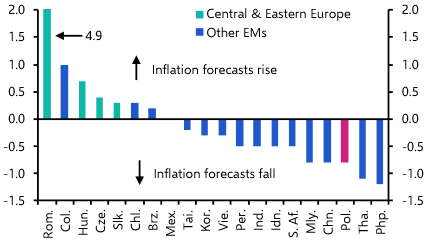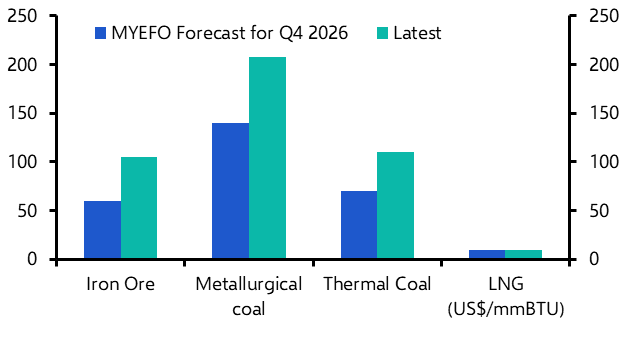Our latest COVID Recovery Monitor reveals a growing divergence between the US economy, which is rebounding, and the euro-zone economy, which is faltering. This is evident in the usual activity data and business surveys, but also in higher frequency data, including our own mobility trackers. (See Chart 1.) Crucially, all the signs suggest that the divergence in performance will widen over the coming months.
Chart 1: Capital Economics Mobility Trackers*

*Trackers expressed as a %-diff from pre-virus level
This is due in part to what is happening on the demand side of each economy. Even before President Biden’s America Rescue Plan was passed, the US had provided more fiscal support than governments in Europe. The passing of that Act, which provided additional stimulus equivalent to 9% of US GDP, means that America’s fiscal response to the pandemic now dwarfs that of Europe’s. (See Chart 2.) The way the package is constructed means that the “fiscal multiplier” – or the bang for the buck in terms of the boost to GDP – is relatively low. But its design, and in particular the use of stimulus cheques, means that the support will come quickly. It’s likely that we’ll see much of the resulting boost to GDP in the second and third quarters of this year.
Chart 2: Discretionary Fiscal Response to COVID-19 (Extra Spending & foregone Revenue % of GDP)

However, there is also an important supply-side aspect of the US-Europe divergence: while most US states are now lifting restrictions on activity and opening up, large parts of Europe are locking down. This reflects the relative success – or otherwise – in getting on top of the virus itself. In the US, infections, hospitalisations and deaths are falling rapidly. In contrast, Europe is in the midst of a third wave of the virus. (See Chart 3.) Over the past week, restrictions on activity have been tightened and extended in France, Italy and Germany.
Chart 3: New COVID-19 Infections (7d MA)

The contrasting picture of infection rates (and hospitalisations) is due to several factors, including the spread of new and more virulent strains in Europe. But vaccine rollout has also played an important role. The US is currently administering around 2.5 million vaccines a day and the total number of vaccines administered so far is equivalent to nearly 40% of the population. Meanwhile, the euro-zone – which has a similar population to the US – is administering 900,000 vaccines a day. In Germany, France, Italy and Spain the total number of vaccines that have been administered so far is equivalent to only 10-15% of the population. (Comprehensive data on vaccine rollout can be accessed on a ready-made dashboard on our analytics platform, CE Interactive.)
Europe’s vaccine programme has been plagued with problems since its inception. Initially, these were related to procurement, which put the European Union on the backfoot when it came to securing vaccine supplies. This has since been compounded by mixed messages from governments about the efficacy and safety of the AstraZeneca jab. There is some evidence that this is now fuelling vaccine hesitancy, which was already comparatively high in some countries. A recent YouGov survey found that a majority of adults in seven European countries, including Germany, France and Spain, believe the AstraZeneca jab to be unsafe.
All this explains the divergence between the US and European economies. In the US, a stimulus-fuelled surge in demand, alongside the restoration of supply as lockdown measures are lifted, is likely to produce extremely rapid rates of economic growth over the coming quarters. We expect GDP to increase by about 2.5% q/q (10% annualised) in Q2 and by 6.5% over 2022 as a whole. Meanwhile, we now expect euro-zone GDP to stagnate in Q2 and expand by 3.0% this year.
The euro-zone’s recovery from the pandemic has not been cancelled, but it has been postponed and it will take longer to complete than in the US. We expect the US to surpass its pre-virus level of GDP in Q2 of this year. In contrast, the euro-zone is unlikely to return to its pre-virus level of GDP until the second half of next year. And some countries, notably Spain, are unlikely to return to pre-virus levels of output until 2023. We will address the question of Europe being left behind in the global recovery in a special 13th April webinar. You can register to attend here.
One consequence of this is that the ECB will have to maintain its policy support for some time to come. Accordingly, it is likely to continue with its net asset purchases under the pandemic emergency purchase programme beyond March 2022, the earliest date at which it has said it might bring purchases under this monetary stimulus tool to an end. But there is a broader question about the longer-term ramifications. We have generally taken a more sanguine view than most about the long-term damage caused by the pandemic. Indeed, unlike in the global financial crisis, we expect most economies to eventually return to their pre-crisis paths of output. (See here for more.) But the longer the recovery takes, the greater the risk of economic scarring as investment is permanently lost and skills start to atrophy. If the pandemic leaves a legacy of permanently lower output anywhere, there’s a good chance it will be in the euro-zone.



